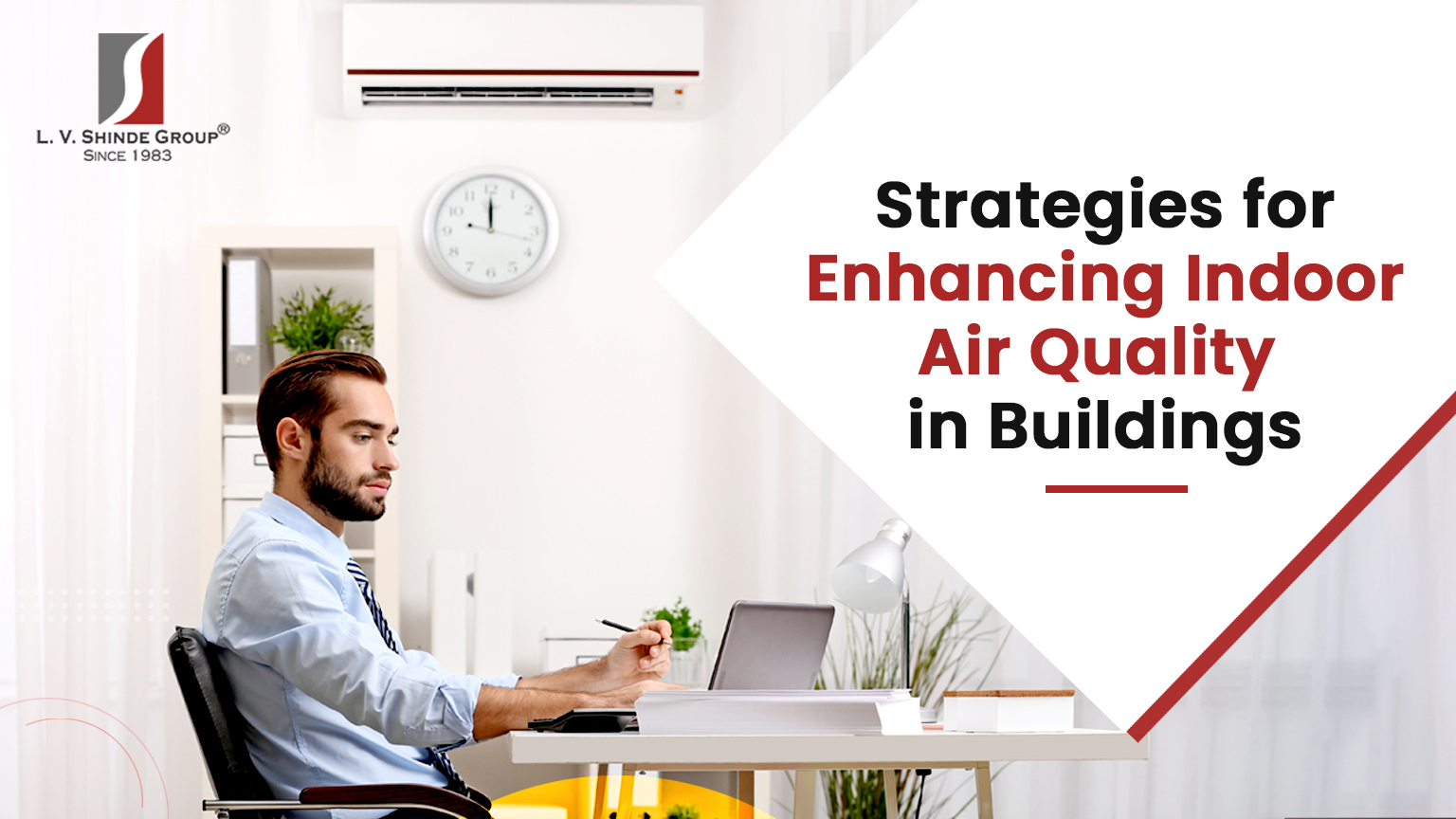10 Strategies for Enhancing Indoor Air Quality in Buildings
In the focus on healthier living and working environments, the quality of indoor air takes centre stage. This comprehensive guide us into the intricate world of Indoor Air Quality (IAQ), exploring its nuances, the repercussions of poor air quality, the significance of maintaining high IAQ, critical variables influencing it, and, most importantly, offering ten practical strategies to enhance IAQ in buildings.
Understanding Indoor Air Quality (IAQ)
Indoor Air Quality (IAQ) is not merely a technical term but a crucial determinant of the well-being of those inhabiting a space. It encompasses a range of factors, from managing pollutants to controlling humidity levels and maintaining effective ventilation systems. This section aims to shed light on the essence of IAQ, emphasizing the vital importance of breathing clean and healthy air.
Impact of Poor Indoor Air Quality
The consequences of poor IAQ extend far beyond mere discomfort. They manifest in a myriad of detrimental impacts on health and overall well-being, including:
- Respiratory Issues:
Prolonged exposure to poor air quality can aggravate existing respiratory problems and contribute to the development of new issues.
- Allergies and Irritation:
Pollutants in the air act as triggers for allergies, leading to irritation of the eyes, nose, and throat.
- Fatigue and Headaches:
Inadequate ventilation and high pollutant levels can contribute to fatigue and frequent headaches among occupants.
- Aggravation of Existing Conditions:
Individuals with pre-existing conditions, such as asthma or cardiovascular issues, may experience worsened symptoms in environments with poor IAQ.
- Reduced Cognitive Function:
Research indicates that poor IAQ can impair cognitive function, affecting concentration, decision-making, and overall productivity.
The Significance of High Indoor Air Quality
High IAQ transcends the realm of luxury; it is a fundamental contributor to health, productivity, and overall satisfaction. This section delves into the significance of maintaining excellent IAQ, from fostering a healthier living environment to enhancing cognitive performance, ensuring occupant well-being, and contributing to an overall positive atmosphere within a building.
Critical Indoor Air Quality Variables
Achieving and maintaining high IAQ hinges on understanding and managing critical variables, including:
- Ventilation Rates:
Adequate ventilation ensures a constant inflow of fresh outdoor air, diluting indoor pollutants and promoting a healthier atmosphere.
- Humidity Levels:
Maintaining optimal humidity levels is crucial to preventing the growth of mold and dust mites, key contributors to indoor air quality issues.
- Pollutant Levels:
Regular monitoring of pollutant levels, such as carbon dioxide, carbon monoxide, and particulate matter, is paramount for effective IAQ management.
- Temperature Control:
Maintaining a comfortable indoor temperature not only ensures occupant comfort but also plays a role in influencing overall air quality.
- Air Filtration:
High-quality air filtration systems are essential in trapping and removing particles, allergens, and pollutants from the air, promoting cleaner and healthier indoor air.
10 Strategies for Enhancing Indoor Air Quality in Buildings
1. Efficient Ventilation Systems:
Ensure that buildings are equipped with efficient ventilation systems that facilitate the inflow of fresh outdoor air, supporting the dilution of indoor pollutants.
2. Regular Maintenance:
Implement routine maintenance schedules for HVAC systems to ensure optimal performance, reducing the risk of indoor air contaminants and enhancing overall IAQ.
3. Air Quality Monitoring:
Utilize advanced air quality monitoring systems to regularly assess pollutant levels, providing real-time data to inform corrective actions and improve IAQ continuously.
4. Humidity Control:
Maintain optimal humidity levels to prevent the growth of mould and dust mites, fostering a healthier indoor environment and contributing to improved IAQ.
5. Strategic Placement of Indoor Plants:
Integrate indoor plants strategically to enhance IAQ by absorbing pollutants and releasing oxygen, creating a symbiotic relationship between nature and indoor spaces.
6. Upgrade Air Filtration Systems:
Invest in high-efficiency air filtration systems, such as HEPA filters, to capture and remove fine particles and allergens effectively, promoting cleaner and healthier indoor air.
7. Implement green cleaning practices:
Adopt environmentally friendly cleaning practices to minimise the use of harsh chemicals that can contribute to indoor pollutants, ensuring a healthier and cleaner indoor environment.
8. Educate Occupants:
Provide educational resources and training to occupants on maintaining a healthy indoor environment, emphasising the importance of individual actions in promoting IAQ.
9. Introduce outdoor air:
Allow for the introduction of fresh outdoor air by strategically opening windows and doors, promoting natural ventilation, and contributing to improved IAQ.
10. Consider air purifiers:
Employ air purifiers equipped with HEPA filters to further enhance indoor air quality by trapping and removing microscopic particles, allergens, and pollutants.
These strategies collectively form a comprehensive approach to achieving and maintaining optimal IAQ in buildings.
FAQs about Indoor Air Quality
Q1. What role does regular maintenance play in maintaining good indoor air quality?
Regular maintenance is integral to ensuring that HVAC systems operate efficiently, reducing the risk of indoor air contaminants, and enhancing overall IAQ.
Q2. How can I assess the indoor air quality in my home or office?
Utilize indoor air quality monitors to assess pollution levels, providing valuable insights and guiding informed decisions about IAQ improvement strategies.
Q3. How often should I change my HVAC filters for better air quality?
HVAC filters should be changed regularly, typically every three months, to maintain optimal air quality and system efficiency.
Q4. What are volatile organic compounds (VOCs), and how can I minimize their presence indoors?
VOCs are indoor air pollutants released by various products. Minimise their presence by choosing low-VOC or VOC-free products and ensuring adequate ventilation.
Q5. Can opening windows improve indoor air quality?
Yes, opening windows allows for the introduction of fresh outdoor air, promoting natural ventilation and significantly improving overall IAQ.
Conclusion
In conclusion, prioritising indoor air quality is an investment in the health and well-being of building occupants. By comprehending the impacts of poor IAQ, recognising the significance of maintaining high IAQ, and implementing practical strategies, facility managers can create environments that foster health, productivity, and overall satisfaction.
Revitalise Your Indoor Air: Choose the Supreme Facility for Cleaner, Healthier Living!
Elevate your indoor air quality with Supreme Facility, where expertise meets a commitment to providing cleaner and healthier living environments. By choosing Supreme Facility, you not only prioritise IAQ but also ensure a comprehensive approach to facility management that puts occupant well-being at the forefront.


